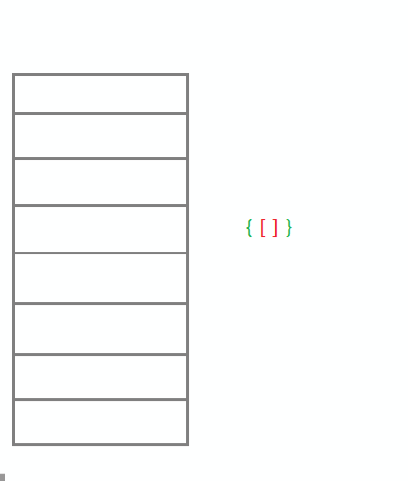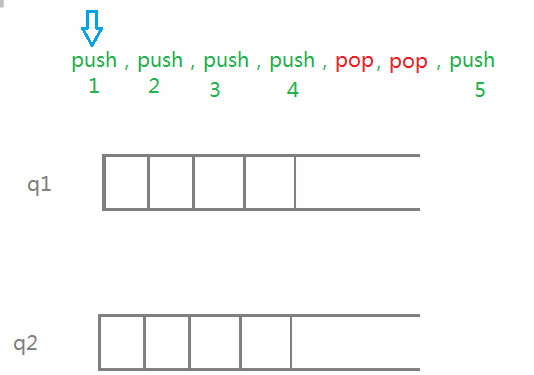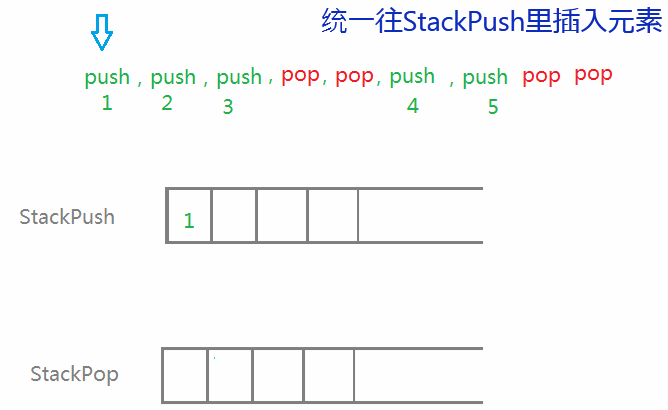<数据结构>刷题笔记——栈和队列篇(动图详解)
文章目录
- 1. 有效的括号
-
- 【链接】
- 【思路】
- 【参考代码】
- 2. 用队列实现栈
-
- 【链接】
- 【思路】
- 【参考代码】
- 3. 用栈实现队列
-
- 【链接】
- 【思路】
- 【参考代码】
- 4. 设计循环队列
-
- 【链接】
- 【思路】
- 【参考代码】
目前在不断更新<数据结构>的知识总结,已经更新完了
,未来我会系统地更新 等内容。
本系列相关文章:
<数据结构>你分得清栈和队列吗?
已完结系列文章总结:
c语言自学教程——博文总结
我的gitee,欢迎来看看:gitee网址
想要一步步稳扎稳打,学习编程的小伙伴可以关注我,文章都是免费的,不错过这一个提升自己的机会!
1. 有效的括号
给定一个只包括 ‘(’,‘)’,‘{’,‘}’,‘[’,‘]’ 的字符串 s ,判断字符串是否有效。
有效字符串需满足:
左括号必须用相同类型的右括号闭合。
左括号必须以正确的顺序闭合。
示例 1:
输入:s = “()”
输出:true
示例 2:
输入:s = “()[]{}”
输出:true
示例 3:
输入:s = “(]”
输出:false
示例 4:
输入:s = “([)]”
输出:false
示例 5:
输入:s = “{[]}”
输出:true
提示:
1 <= s.length <= 104
s 仅由括号 ‘()[]{}’ 组成
【链接】
20. 有效的括号
【思路】
数括号能不能数出来呢?不行,"([)]"的数量符合要求但括号的种类不匹配。
让我们换一种思路,运用我们学到的栈。遇到左括号就入栈,遇到右括号就出栈,栈是后进先出的,出栈出的是最近入进去的括号,如果都可以匹配上,就返回“true”,否则返回“false”。

思路就这捋顺了,接下来就要写代码了。但问题来了,从哪能搞来栈用呢?因为我们还没学到C++在这就只能憋屈得自己写个栈了,我上一篇文章<数据结构>你分得清栈和队列吗?写的栈直接复制过来用,这就是为什么参考代码那么长,其实新东西只有最后那一点。
在此强调一下,一定要保证栈的代码正确再使用,否则会bug重重,很难改。
【参考代码】
typedef int STDataType;
typedef struct Stack
{
int* a;
int top;//栈顶的位置
int capacity;//容量
}ST;
void StackInit(ST* ps)
{
assert(ps);
ps->a = NULL;
ps->capacity = 0;
ps->top = 0;
}
void StackDestory(ST* ps)
{
assert(ps);
free(ps->a);
ps->a = NULL;
ps->capacity = 0;
ps->top = 0;
}
void StackPush(ST* ps, STDataType x)
{
assert(ps);
//满了扩容
if (ps->top == ps->capacity)
{
int newCapacity = ps->capacity == 0 ? 4 : 2 * ps->capacity;
ps->a = (STDataType*)realloc(ps->a, newCapacity*sizeof(STDataType));
if (ps->a == NULL)
{
printf("realloc fail");
exit(-1);
}
ps->capacity = newCapacity;
}
ps->a[ps->top] = x;
ps->top++;
}
void StackPop(ST* ps)
{
assert(ps);
assert(ps->top > 0);
ps->top--;
}
bool StackEmpty(ST* ps)
{
assert(ps);
return ps->top == 0;
}
STDataType StackTop(ST* ps)
{
assert(ps);
assert(ps->top > 0);
return ps->a[ps->top - 1];
}
int StackSize(ST* ps)//元素个数
{
assert(ps);
return ps->top;
}
bool isValid(char * s){
ST st;
StackInit(&st);
while(*s)
{
if(*s == '{'||*s == '['||*s == '(')
{
StackPush(&st, *s);
s++;
}
else
{
if(StackEmpty(&st))//防越界
return false;
char top = StackTop(&st);
StackPop(&st);
if((*s == '}' && top != '{')
||(*s == ']' && top != '[')
||(*s == ')' && top != '('))
{
StackDestory(&st);
return false;
}
s++;
}
}
bool ret = StackEmpty(&st);
StackDestory(&st);
return ret;
}
2. 用队列实现栈
请你仅使用两个队列实现一个后入先出(LIFO)的栈,并支持普通栈的全部四种操作(push、top、pop 和 empty)。
实现 MyStack 类:
void push(int x) 将元素 x 压入栈顶。
int pop() 移除并返回栈顶元素。
int top() 返回栈顶元素。
boolean empty() 如果栈是空的,返回 true ;否则,返回 false 。
注意:
你只能使用队列的基本操作 —— 也就是 push to back、peek/pop from front、size 和 is empty 这些操作。
你所使用的语言也许不支持队列。 你可以使用 list (列表)或者 deque(双端队列)来模拟一个队列 , 只要是标 准的队列操作即可。
示例:
输入:
[“MyStack”, “push”, “push”, “top”, “pop”, “empty”]
[[], [1], [2], [], [], []]
输出:
[null, null, null, 2, 2, false]解释:
MyStack myStack = new MyStack();
myStack.push(1);
myStack.push(2);
myStack.top(); // 返回 2
myStack.pop(); // 返回 2
myStack.empty(); // 返回 False
提示:
1 <= x <= 9
最多调用100 次 push、pop、top 和 empty
每次调用 pop 和 top 都保证栈不为空
进阶:你能否仅用一个队列来实现栈。
【链接】
225. 用队列实现栈
【思路】
用两个队列实现一个栈。两者的最大不同就是队列是先进先出的,栈是后进先出的。
实现入栈就随便把数据放到一个队列里
想要实现出栈,得先把挡在前面的数据放到另一个队列中,最后才能出栈
如果后续还要实现入栈就入到仍有数据的队列中
这是一个典型的接口型OJ题,你需要完善里面的函数。
队列和上一题一样,目前只能用自己写的复制到代码中
【参考代码】
typedef int QDataType;
//节点
typedef struct QueueNode
{
QDataType data;
struct QueueNode* next;
}QNode;
//找到头和尾
typedef struct Queue
{
QNode* head;
QNode* tail;
}Queue;
void QueueInit(Queue* pq);
void QueueDestory(Queue* pq);
void QueuePush(Queue* pq, QDataType x);
void QueuePop(Queue* pq);
bool QueueEmpty(Queue* pq);
size_t QueueSize(Queue* pq);
QDataType QueueFront(Queue* pq);
QDataType QueueBack(Queue* pq);
void QueueInit(Queue* pq)
{
assert(pq);
pq->head = pq->tail = NULL;
}
void QueueDestory(Queue* pq)
{
assert(pq);
QNode* cur = pq->head;
while (cur)
{
QNode* next = cur->next;
free(cur);
cur = next;
}
pq->head = pq->tail = NULL;
}
void QueuePush(Queue* pq, QDataType x)
{
assert(pq);
QNode* newnode = (QNode*)malloc(sizeof(QNode));
assert(newnode);
newnode->data = x;
newnode->next = NULL;
if (pq->tail == NULL)
{
assert(pq->head == NULL);
pq->head = pq->tail = newnode;
}
else
{
pq->tail->next = newnode;
pq->tail = newnode;
}
}
void QueuePop(Queue* pq)
{
assert(pq);
assert(pq->head && pq->tail);
if (pq->head->next == NULL)
{
free(pq->head);
pq->head = pq->tail = NULL;
}
else
{
QNode* next = pq->head->next;
free(pq->head);
pq->head = next;
}
}
bool QueueEmpty(Queue* pq)
{
assert(pq);
return pq->head == NULL;
}
size_t QueueSize(Queue* pq)
{
assert(pq);
size_t size = 0;
QNode* cur = pq->head;
while (cur)
{
size++;
cur = cur->next;
}
return size;
}
QDataType QueueFront(Queue* pq)
{
assert(pq);
assert(pq->head);
return pq->head->data;
}
QDataType QueueBack(Queue* pq)
{
assert(pq);
assert(pq->tail);
return pq->tail->data;
}
typedef struct {
Queue q1;
Queue q2;
} MyStack;
MyStack* myStackCreate() {
MyStack* pst = (MyStack*)malloc(sizeof(MyStack));
assert(pst);
QueueInit(&pst->q1);
QueueInit(&pst->q2);
return pst;
}
void myStackPush(MyStack* obj, int x) {
assert(obj);
if(!QueueEmpty(&obj->q1))
{
QueuePush(&obj->q1, x);
}
else
{
QueuePush(&obj->q2, x);
}
}
int myStackPop(MyStack* obj) {
assert(obj);
Queue* emptyQ = &obj->q1;
Queue* nonEmptyQ = &obj->q2;
if(!QueueEmpty(&obj->q1))
{
emptyQ = &obj->q2;
nonEmptyQ = &obj->q1;
}
//把非空队列的前N个数据,导入空队列,只剩最后一个删掉
//就实现了后进先出
while(QueueSize(nonEmptyQ)>1)
{
QueuePush(emptyQ, QueueFront(nonEmptyQ));
QueuePop(nonEmptyQ);
}
int top = QueueFront(nonEmptyQ);
QueuePop(nonEmptyQ);//记得pop掉
return top;
}
int myStackTop(MyStack* obj) {
assert(obj);
if(!QueueEmpty(&obj->q1))
{
return QueueBack(&obj->q1);
}
else
{
return QueueBack(&obj->q2);
}
}
bool myStackEmpty(MyStack* obj) {
assert(obj);
return QueueEmpty(&obj->q1) && QueueEmpty(&obj->q2);
}
void myStackFree(MyStack* obj) {
assert(obj);
QueueDestory(&obj->q1);
QueueDestory(&obj->q2);
free(obj);
obj = NULL;
}
3. 用栈实现队列
请你仅使用两个栈实现先入先出队列。队列应当支持一般队列支持的所有操作(push、pop、peek、empty):
实现 MyQueue 类:
void push(int x) 将元素 x 推到队列的末尾
int pop() 从队列的开头移除并返回元素
int peek() 返回队列开头的元素
boolean empty() 如果队列为空,返回 true ;否则,返回 false
说明:
你 只能 使用标准的栈操作 —— 也就是只有 push to top, peek/pop from top, size, 和 is empty 操作是合法的。
你所使用的语言也许不支持栈。你可以使用 list 或者 deque(双端队列)来模拟一个栈,只要是标准的栈操作即可。
示例 1:
输入:
[“MyQueue”, “push”, “push”, “peek”, “pop”, “empty”]
[[], [1], [2], [], [], []]
输出:
[null, null, null, 1, 1, false]解释:
MyQueue myQueue = new MyQueue();
myQueue.push(1); // queue is: [1]
myQueue.push(2); // queue is: [1, 2] (leftmost is front of the queue)
myQueue.peek(); // return 1
myQueue.pop(); // return 1, queue is [2]
myQueue.empty(); // return false
提示:
1 <= x <= 9
最多调用 100 次 push、pop、peek 和 empty
假设所有操作都是有效的 (例如,一个空的队列不会调用 pop 或者 peek 操作)
进阶:
你能否实现每个操作均摊时间复杂度为 O(1) 的队列?换句话说,执行 n 个操作的总时间复杂度为 O(n) ,即使其中一个操作可能花费较长时间。
【链接】
232. 用栈实现队列
【思路】
这跟上一题是姐妹题
但有些不同,因为从一个栈到另一个栈,内容的顺序会颠倒过来,这次我们规定一个固定的实行入队列的栈,和一个固定的出队列的栈。
【参考代码】
typedef int STDataType;
typedef struct Stack
{
int* a;
int top;//栈顶的位置
int capacity;//容量
}ST;
void StackInit(ST* ps);//初始化
void StackDestory(ST* ps);//销毁
void StackPush(ST* ps, STDataType x);//入栈
void StackPop(ST* ps);//出栈
bool StackEmpty(ST* ps);//判断栈是否为空
STDataType StackTop(ST* ps);//返回栈顶元素
int StackSize(ST* ps);//栈里的元素个数
void StackInit(ST* ps)
{
assert(ps);
ps->a = NULL;
ps->capacity = 0;
ps->top = 0;
}
void StackDestory(ST* ps)
{
assert(ps);
free(ps->a);
ps->a = NULL;
ps->capacity = 0;
ps->top = 0;
}
void StackPush(ST* ps, STDataType x)
{
assert(ps);
//满了扩容
if (ps->top == ps->capacity)
{
int newCapacity = ps->capacity == 0 ? 4 : 2 * ps->capacity;
ps->a = (STDataType*)realloc(ps->a, newCapacity*sizeof(STDataType));
if (ps->a == NULL)
{
printf("realloc fail");
exit(-1);
}
ps->capacity = newCapacity;
}
ps->a[ps->top] = x;
ps->top++;
}
void StackPop(ST* ps)
{
assert(ps);
assert(ps->top > 0);
ps->top--;
}
bool StackEmpty(ST* ps)
{
assert(ps);
return ps->top == 0;
}
STDataType StackTop(ST* ps)
{
assert(ps);
assert(ps->top > 0);
return ps->a[ps->top - 1];
}
int StackSize(ST* ps)//元素个数
{
assert(ps);
return ps->top;
}
typedef struct {
ST pushST;
ST popST;
} MyQueue;
MyQueue* myQueueCreate() {
MyQueue* pst = (MyQueue*)malloc(sizeof(MyQueue));
assert(pst);
StackInit(&pst->pushST);
StackInit(&pst->popST);
return pst;
}
void myQueuePush(MyQueue* obj, int x) {
assert(obj);
StackPush(&obj->pushST,x);
}
int myQueuePop(MyQueue* obj) {
assert(obj);
//空了再加进去
if(StackEmpty(&obj->popST))
{
while(StackSize(&obj->pushST))
{
StackPush(&obj->popST, StackTop(&obj->pushST));
StackPop(&obj->pushST);
}
}
int head = StackTop(&obj->popST);
StackPop(&obj->popST);
return head;
}
int myQueuePeek(MyQueue* obj) {
assert(obj);
//空了再加进去
if(StackEmpty(&obj->popST))
{
while(StackSize(&obj->pushST))
{
StackPush(&obj->popST, StackTop(&obj->pushST));
StackPop(&obj->pushST);
}
}
int head = StackTop(&obj->popST);
return head;
}
bool myQueueEmpty(MyQueue* obj) {
assert(obj);
return StackEmpty(&obj->pushST) && StackEmpty(&obj->popST) ;
}
void myQueueFree(MyQueue* obj) {
assert(obj);
StackDestory(&obj->pushST);
StackDestory(&obj->popST);
free(obj);
}
/**
* Your MyQueue struct will be instantiated and called as such:
* MyQueue* obj = myQueueCreate();
* myQueuePush(obj, x);
* int param_2 = myQueuePop(obj);
* int param_3 = myQueuePeek(obj);
* bool param_4 = myQueueEmpty(obj);
* myQueueFree(obj);
*/
4. 设计循环队列
设计你的循环队列实现。 循环队列是一种线性数据结构,其操作表现基于 FIFO(先进先出)原则并且队尾被连接在队首之后以形成一个循环。它也被称为“环形缓冲器”。
循环队列的一个好处是我们可以利用这个队列之前用过的空间。在一个普通队列里,一旦一个队列满了,我们就不能插入下一个元素,即使在队列前面仍有空间。但是使用循环队列,我们能使用这些空间去存储新的值。
你的实现应该支持如下操作:
MyCircularQueue(k): 构造器,设置队列长度为 k 。
Front: 从队首获取元素。如果队列为空,返回 -1 。
Rear: 获取队尾元素。如果队列为空,返回 -1 。
enQueue(value): 向循环队列插入一个元素。如果成功插入则返回真。
deQueue(): 从循环队列中删除一个元素。如果成功删除则返回真。
isEmpty(): 检查循环队列是否为空。
isFull(): 检查循环队列是否已满。
示例:
MyCircularQueue circularQueue = new MyCircularQueue(3); // 设置长度为 3
circularQueue.enQueue(1); // 返回 true
circularQueue.enQueue(2); // 返回 true
circularQueue.enQueue(3); // 返回 true
circularQueue.enQueue(4); // 返回 false,队列已满
circularQueue.Rear(); // 返回 3
circularQueue.isFull(); // 返回 true
circularQueue.deQueue(); // 返回 true
circularQueue.enQueue(4); // 返回 true
circularQueue.Rear(); // 返回 4
提示:
所有的值都在 0 至 1000 的范围内;
操作数将在 1 至 1000 的范围内;
请不要使用内置的队列库。
【链接】
622. 设计循环队列
【思路】
为了能用head和tail判断队列是满还是空,我们想要存放n个数据得开辟n+1个空间。
这样的话front=tail时是空,tail+1=front时(不越界的情况)是满,能够区别开
这题用顺序表或链表都能实现,我为了更方便的找到尾元素就打算用顺序表(数组)实现一下,这个的要小心到了数组尾部要回到头部再走
【参考代码】
typedef struct {
int* a;
int front;
int tail;
int k;
} MyCircularQueue;
bool myCircularQueueIsEmpty(MyCircularQueue* obj);
bool myCircularQueueIsFull(MyCircularQueue* obj);
MyCircularQueue* myCircularQueueCreate(int k) {
MyCircularQueue* obj = (MyCircularQueue*)malloc(sizeof(MyCircularQueue));
obj->a = (int*)malloc(sizeof(int)*(k+1));
obj->front = obj->tail = 0;
obj->k = k;
return obj;
}
bool myCircularQueueEnQueue(MyCircularQueue* obj, int value) {
assert(obj);
if(myCircularQueueIsFull(obj))
return false;
obj->a[obj->tail] = value;
if(obj->tail == obj->k)
{
obj->tail = 0;
}
else
{
obj->tail++;
}
return true;
}
bool myCircularQueueDeQueue(MyCircularQueue* obj) {
assert(obj);
if(myCircularQueueIsEmpty(obj))
return false;
if(obj->front == obj->k)
{
obj->front = 0;
}
else
{
obj->front++;
}
return true;
}
int myCircularQueueFront(MyCircularQueue* obj) {
assert(obj);
if(!myCircularQueueIsEmpty(obj))
{
return obj->a[obj->front];
}
else
{
return -1;
}
}
int myCircularQueueRear(MyCircularQueue* obj) {
assert(obj);
if(!myCircularQueueIsEmpty(obj))
{
if(obj->tail == 0)
{
return obj->a[obj->k];
}
else
{
return obj->a[obj->tail-1];
}
}
else
{
return -1;
}
}
bool myCircularQueueIsEmpty(MyCircularQueue* obj) {
assert(obj);
return obj->front == obj->tail;
}
bool myCircularQueueIsFull(MyCircularQueue* obj) {
assert(obj);
if(obj->tail == obj->k)
{
return obj->front == 0;
}
else
{
return obj->front == obj->tail+1;
}
}
void myCircularQueueFree(MyCircularQueue* obj) {
assert(obj);
free(obj->a);
free(obj);
obj = NULL;
}
/**
* Your MyCircularQueue struct will be instantiated and called as such:
* MyCircularQueue* obj = myCircularQueueCreate(k);
* bool param_1 = myCircularQueueEnQueue(obj, value);
* bool param_2 = myCircularQueueDeQueue(obj);
* int param_3 = myCircularQueueFront(obj);
* int param_4 = myCircularQueueRear(obj);
* bool param_5 = myCircularQueueIsEmpty(obj);
* bool param_6 = myCircularQueueIsFull(obj);
* myCircularQueueFree(obj);
*/
动图花了我很多心思,希望对大家有所帮助。☀️
由于本人实力有限,如果文中出现错误❌请提出来。
如果觉得有所收获,还请点个赞❤️鼓励一下博主。
还不太懂的朋友也不要失落,先收藏起来,等到合适的时机再看一看,也许能够恍然大悟,有所得。
<数据结构>系列还在不断更新,关注我,跟我一起一步一步学习数据结构把!


